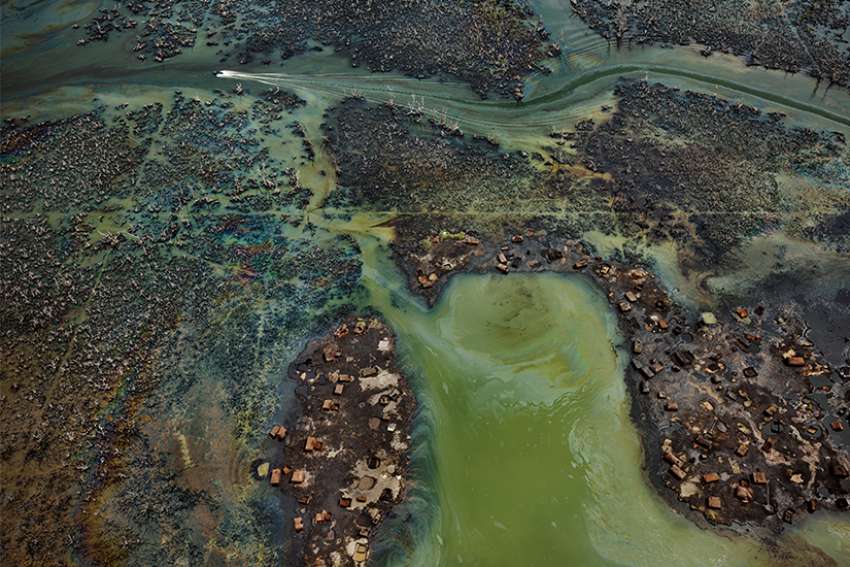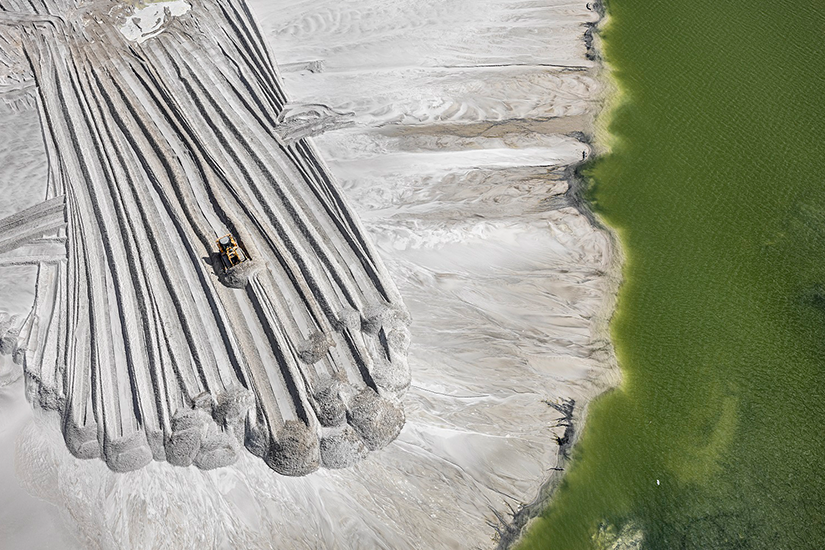He is attending the Art Gallery of Ontario show titled Anthropocene. In size and detail, the art is hyperreal. The exhibition isn’t about an idea, an abstraction or a political cause. Photographer Edward Burtynsky and filmmakers Jennifer Baichwal and Nicholas de Pencier are demanding that viewers face up to reality.
Burtynsky’s immense industrial landscapes — immense in terms of subject and immensely rendered in wall-sized prints — are at the centre of this collaboration by three Canadian artists. Burtynsky’s work is collected in more than 50 museums, including the Guggenheim in New York, the National Gallery of Canada and the Bibliothèque Nationale in Paris. He is the big name, the big draw at the AGO who produces big photographs that show the big scars humans have left on the surface of their planet.
Anthropocene is the word scientists use to define our present geologic age — like the Cretaceous (dinosaurs), the Pleistocene (wooly mammoths) and the Holocene (post-ice age). The Anthropocene age began with testing atomic bombs in the 1940s. Fallout from 20th-century nuclear weapons testing left a characteristic radioactive marker in rocks globally, a sign which future geologists should be able to measure for thousands of years. This is the age defined by human activity which is now shaping the entire global ecosystem.
Anthropocene is also a central idea in contemporary Catholic theology, as theologians try to understand the ethical and spiritual meaning of living at a time when we have taken creation into our own hands.
Pope Francis wrote about this in his 2015 encyclical Laudato Si’.
“As Christians, we are also called to accept the world as a sacrament of communion, as a way of sharing with God and our neighbours on a global scale,” he said. “It is our humble conviction that the divine and the human meet in the slightest detail in the seamless garment of God’s creation, in the last speck of dust of our planet.”
But we’re not treating creation as a sacrament, said O’Hara, as he toured a press preview of the Sept. 28 to Jan. 6 exhibition. O’Hara teaches theology at the University of Toronto’s St. Michael’s College and directs the Elliott Allen Institute for Theology and Ecology.
“We’re now determining the conditions under which every other species is evolving. We are changing the conditions under which they are evolving,” said O’Hara. “Do we have the wisdom to do that?”
When O’Hara began lecturing about the Anthropocene age seven years ago, audiences pushed back. People couldn’t believe that humans had taken control of the climate and every biological process dependent on it. Nor did they see the science as theologically significant.
But since Pope Francis addressed the global community and warned that we face an ecological crisis beyond all borders — a crisis embedded in our culture and our economies — O’Hara finds a little more willingness among students and parishioners to think of how humans are remaking the world given to us by God.
“If your faith doesn’t engage in this issue, then it’s not the faith that was given to us by Christ,” O’Hara told The Catholic Register standing in front of a giant Burtynsky photograph of immense salt pans in the Kutch desert of Gujarat, India. “Christ came to say the status quo is wrong and it needs to be changed in a radical and fundamental way. That message is here, right now.”
Burtynsky told reporters he wanted “to evangelize that word (Anthropocene).” He understood that many people would not be familiar with the vocabulary, or with the idea that we live in a human-defined geologic age. But people need to be aware, he said.
“It’s a word that is important enough to take that risk,” said the photographer.
The realism of Burtynsky’s enormous, detailed photographic prints, along with Baichwal and de Pencier’s immersive films and the accompanying three-dimensional augmented reality experiences that round out the show, is central to the message behind the art, said AGO curator of photography Sophie Hackett.
“The artists are really seeking to show us, as one of them has put it, business as usual. This is how we interact with our planet,” she said.
“Documentary (film) is about conveying the real,” said Baichwal. “We wanted this to be experiential rather than didactic. We wanted to acknowledge — not just acknowledge but honour — the complexity of this.”
To create a more vivid experience of the images on display, the exhibition comes with a free augmented reality application called AVARA, available for both android and Apple phones. There are more than 50 works on display simultaneously at the AGO and the National Gallery of Canada in Ottawa. The show will travel in the spring to Bologna, Italy, for a show at the Fondazione MAST, which co-produced the exhibition.
Everybody needs to see this exhibition, but Christians need to bring their faith to it and the reality it represents, said O’Hara.
“As Christians, we realize that what we’re calling all humans to do is a re-invention of who we are on a radical, deep level,” he said. “On every level — economic, political, agricultural, the built environment, our education — everything we do has to be re-invented. Because the way we’ve been doing it has been destroying the planet.”



